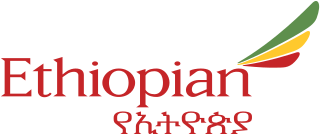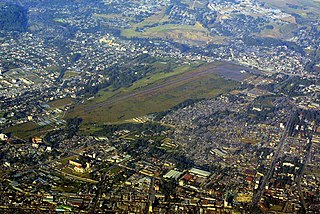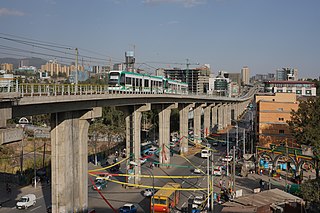Related Research Articles

Transport in Ethiopia is overseen by the Ministry of Transport and Communications. Over the last years, the Ethiopian federal authorities have significantly increased funding for rail and road construction to build an infrastructure, that allows better economic development.

Addis Ababa is the capital and largest city of Ethiopia and Oromia. In the 2007 census, the city's population was estimated to be 2,739,551 inhabitants. Addis Ababa is a highly developed and important cultural, artistic, financial and administrative centre of Ethiopia.

Ethiopian Airlines, formerly Ethiopian Air Lines (EAL), is the flag carrier of Ethiopia, and is wholly owned by the country's government. EAL was founded on 21 December 1945 and commenced operations on 8 April 1946, expanding to international flights in 1951. The firm became a share company in 1965 and changed its name from Ethiopian Air Lines to Ethiopian Airlines.

Addis Ababa Bole International Airport is an international airport in Addis Ababa, Ethiopia. It is in the Bole district, 6 km (3.7 mi) southeast of the city centre and 65 km (40 mi) north of Bishoftu. The airport was formerly known as Haile Selassie I International Airport. It is the main hub of Ethiopian Airlines, the national airline that serves destinations in Ethiopia and throughout the African continent, as well as nonstop service to Asia, Europe, North America and South America. The airport is also the base of the Ethiopian Aviation Academy. As of June 2018, nearly 450 flights per day were departing from and arriving at the airport.
Rail transport in Ethiopia is done within the National Railway Network of Ethiopia, which currently consists of three electrified standard gauge railway lines: the Addis Ababa–Djibouti Railway, the Awash–Weldiya Railway and the Weldiya–Mekelle Railway. Other lines are still in the planning phase. There is also an urban light rail system in the country's capital, the Addis Ababa Light Rail.

Current railway stations in Ethiopia are served by standard gauge railways of the National Railway Network of Ethiopia which is mostly under construction, except the Addis Ababa–Djibouti Railway. Other stations were built for the in 2018 still operating metre gauge Ethio-Djibouti Railways, although this railway has officially been superseded by the new Addis Ababa-Djibouti Railway.

The Ethio-Djibouti Railway is a metre gauge railway in the Horn of Africa that once connected Addis Ababa to the port city of Djibouti. The operating company was also known as the Ethio-Djibouti Railways. The railway was built in 1894–1917 to connect the Ethiopian capital city to French Somaliland. During early operations, it provided landlocked Ethiopia with its only access to the sea. After World War II, the railway progressively fell into a state of disrepair due to competition from road transport.
Rail transport in Djibouti is administered through the Ethio-Djibouti Standard Gauge Rail Transport Share Company, a bi-national company between Ethiopia and Djibouti to manage the only railway in Djibouti, the electrified standard gauge international Addis Ababa–Djibouti Railway. This railway opened on 1 January 2018 replaced the international metre gauge railway from Djibouti's capital Djibouti City to the Ethiopian capital Addis Ababa, which was officially decommissioned in 2016.
Railway stations in Djibouti are served by standard gauge railways of the Djiboutian Railway Company.
Anbessa City Bus Service Enterprise or Anbessa is a state-owned public transport operator headquartered in Addis Ababa, Ethiopia.

Lideta Airport also colloquially known as the Old Airport is a decommissioned military airport located in Addis Ababa, Ethiopia.

The Addis Ababa Light Rail is a light rail system in Addis Ababa, Ethiopia. It is the first light rail and rapid transit in eastern and sub-saharan Africa.

The Addis Ababa–Djibouti Railway is a new standard gauge international railway that serves as the backbone of the new Ethiopian National Railway Network. The railway was inaugurated by Prime Minister Hailemariam Desalegn on January 1, 2018. It provides landlocked Ethiopia with access to the sea, linking Ethiopia's capital of Addis Ababa with Djibouti and its Port of Doraleh. More than 95% of Ethiopia's trade passes through Djibouti, accounting for 70% of the activity at the Port of Djibouti.

METEC is an Ethiopian arms and machinery industry founded in 2010. Being the state largest military industrial complex, it is responsible for the production of military equipment and civilian products. METEC works with foreign companies such as Alstom from France, and Spire Corporation from America.

Nagad Railway Station is the new and only passenger rail station of Djibouti City, the capital of Djibouti.

The Awash–Weldiya Railway is a standard gauge railway under construction, that will serve as a northward extension of the new Ethiopian National Railway Network.

The Weldiya–Mekelle Railway is a standard gauge railway under construction, that will serve as a northward extension of the new Ethiopian National Railway Network and connects Mekelle to Addis Ababa and Djibouti via the Awash-Weldiya railway.
The Kenya Standard Gauge Railway is a railway system that will connect Kenyan cities, and link the country to the neighboring country of Uganda, and through Uganda, to South Sudan, the Democratic Republic of the Congo, Rwanda, and Burundi. There are also plans to link to Addis Ababa, in neighboring Ethiopia to the north. The first segment, between Mombasa and Nairobi, opened passenger rail service in June 2017, and freight rail service in January 2018. Other segments are under construction or planned. The new Standard Gauge Railway (SGR), is intended to replace the old, inefficient metre-gauge railway system.

Urban rail transit in Africa has emerged as a growing form of transit due to rapid urbanization that has occurred in recent decades across the continent. Some of these transit systems are older and more developed, such as the metro in Cairo which opened in 1987. Others such as the light-rail system in Addis Ababa are much more recent, which opened 2015. A variety of technologies are being used ranging from light-rail, bus rapid-transit, and commuter-rail etc. Africa for several decades saw minimal investment in rail infrastructure, but in recent years due to urban population growth and improved financing options, investment in rail networks has increased.

Transport in Addis Ababa includes cars, buses and light rail. In several occasions, these services often foiled with structural problems that impacts urban mobility. Anbessa Bus, Higer Bus and Star Alliance Bus are popular buses in Addis Ababa. Besides, share taxis such as sedan and blue and white minibuses are typical mode of transportation still today, carrying up to 12 passengers.
References
- ↑ "Ethiopian Railways Corporation". The World Folio. Retrieved 16 March 2018.
- ↑ Taye, Dawit (13 January 2018). "ERC to invest on railway Academy". The Reporter. Retrieved 16 March 2018.